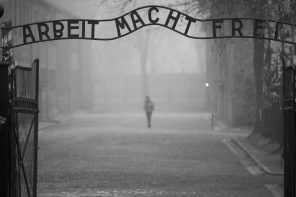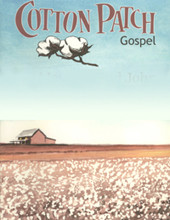Popular history in Protestant circles has often reimagined the medieval church as suffering from severe illiteracy in lay Christians. Images of Bibles chained to lecterns come to mind and the rally cry of sola scriptura takes on as much a visual argument–a Bible in each and every hand–as it does a devotional and doctrinal one.
It has only been in the past fifty years that the scholarship of researchers like Dom. Jean Leclercq and Caroline Walker Bynum have opened the conversation to challenging this interpretation of the medieval lay Christian. Leclercq and Bynum, along with others, have advocated a reading of the medievals that recognizes a distinction between textual and visual literacy. The medieval Christian might not have had textual literacy, might not have had access to the Scripture directly. However, she would have had access to the doctrinal and mysterious aspects of the Faith through a well-developed visual literacy, thanks to highly iconographic stained glass and the liturgical structure of the Mass itself. Visual elements became the teaching tools of the Church as a whole, which is one explanation for the extensively illuminated copies of the Psalms and iconographic reference books popular in the late middle ages.
One such visual theology in the Mass that remains alive in Roman Catholic, Anglican, and high-Episcopal churches to this day is the representation of the Trinity iconographically through symbolic objects.
At the beginning of the Mass, a censer, an ornate ball hung by a chain in which incense is burned, is brought down the central aisle. This censer represents God the Father, drawing both on the image of God in the smoking fire pot passing before Abraham in Genesis and of the incense that was to shroud the priests entering the tabernacle and later the temple throughout the Old Testament.
Following, a cross or crucifix processes, quite strikingly recalling Christ’s entering into the world and His full humanity along with His full divinity, the former perhaps no more apparent than in the scandal of the cross.
Afterward, candles on either side of the Gospel, the Word, proceed in likewise fashion. Here, there is ambiguity as to what is exactly pointing to the Holy Ghost, but worshipers are invited to consider that the Light of the world, His Word, and the reception of it are somehow entirely bound together and only realized through the work of the Spirit. Moreover, the flames, in the very least, recall Pentecost, and that it was not until the reception of the Spirit that Peter was able to interpret the Word as pointing to Christ in the unity of God the Father in his sermon thereafter.
The Mass opens even before the name of the Trinity is spoken by being led into worship by three distinct elements that represent the unique character of the Trinity itself.
What is fascinating about this iconography, as well as arresting when considered from a medieval perspective, is that there is no definitive theological statement being asserted by this icon.
Rudimentary elements—three Persons, co-eternal, co-existant, consubstantial—are visually implied, but a specific argument for a particular Trinitarian theology is not. It is fundamentally orthodox, but without the necessity of nuance.
What this perhaps achieved for the lay medieval mind and can achieve in our own today is a healthy and significant recognition of the mystery of God.
Whereas you shall find no single Scripture that defines the Trinity, you can arrive at a general etching of its mysteriousness through reading the whole of the Scripture in conversation with itself.
Visually, the censer, crucifix, and candlestick invite similar reflection.
There is an unspoken nod to the incomprehensibility of the Almighty while at the same time employing elements that He has considered effective forms of His revelation to us: the Father in the fire pot, the Son upon the Cross, the Spirit in the flame.
Though we arrive at nothing systematically conclusive thanks to this visual representation, we perhaps better get at the otherness of God and the impossibility of what we as Christians claim to believe. Perhaps, this kind of visual theological imagination makes the lay medieval textual illiteracy not quite so offensive. Moreover, it may call suspect our lay modern visual illiteracy, which delights in tidy definitions for doctrines that are perhaps too large for such nuance.






Great post, Preston. You mentioned the flames and the Spirit and the ambiguity there…I wonder if that might refer to Zechariah 4, where the prophet asks about the lampstands, and the answer comes back, “Not by might or by power, but by My Spirit.” And Revelation 4, where the seven lamps burning with fire are the seven Spirits of God.
Good work. I always like the reminder of mystery in God. I’m so keen to sniff it all out, but it’s good to remember that where there is mystery, there is pursuit, and where there is pursuit, there’s a continual “finding and being found.”
Good post, Preston.
1) I’ve never come across this comparison of the censer/cross/candles to the Trinity before. Can you point me to a medieval source where the comparison is made, or earlier? Is this something medieval lay Christians would have been aware of?
2) As you know, patristic, medieval, and modern Christian imagery uses the flame as the symbol of the Spirit, from Pentecost through Dionysius through the Cloud of Unknowing through John of the Cross. This flame, which warms and illuminates, is identical with God’s love, communicated through the Spirit, which enlightens the mind and burns in the heart. I think that, for any lay Christian familiar with the story of Pentecost, especially for a Christian familiar with the Church’s mystical tradition (admittedly not too likely in your everyday lay person), it would have been very clear “as to what exactly is pointing to the Holy Ghost” in the image of the candle!
3) You mention the candles being brought in to accompany the Word during the opening procession. However, the candles would have spent, and do spend, the majority of the liturgy on the altar, the place of Sacrifice. They do travel once again to the Gospel, as does the censer, when the Gospel is read, and then return to the altar. Additionally, the censer is once again used when the altar is prepared for the Liturgy of the Eucharist, to cense the altar, the priest, and the people, just as it was used to cense the Book of the Gospel, visually (and olfactorily!) showing that Christ is present in the priest, the people, the Word, and the Eucharist.
And especially during the Eucharist, the heart of the Mass, the censer is used, the sign of the cross is made (and the Word spoken) over the Gifts, and the candles rest on the altar itself – thus showing forth how the entire Trinity participates in Christ’s saving work on the Cross.
Thanks for this connection, which I hadn’t made before. I’ll be sure to notice it the next time I go to Mass!
Preston–I love this illumination of symbols and symbolic actions that take place right under our noses. As Cole asked–is this something you discerned on your own? Like the recent ITIA lecture on Gothic cathedrals, the world of the church grows richer and richer as we surrender to the weight of tradition.